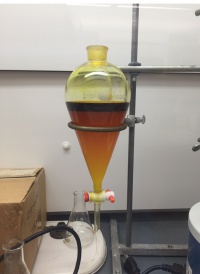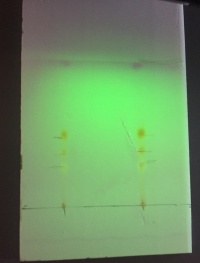Curcumin Research
You have reached the page dedicated to the research of curcumin, a secondary plant metabolite and biophenol of interest to the Sturgeon Research Project. This page was created and is maintained by Stephanie Saey and Nadia Ayala.
Curcumin Research Initiative
Preparation of Curcuminoid Standards from Turmeric Plant
Curcumin is a secondary plant metabolite of the turmeric herb Curcuma longa. The term "curcumin" has been used to refer to the bioactive molecule, but in reality curcumin has three derivatives (I/II/III) of different molecular structures: curcumin (I), demethoxycurcumin (II), and bisdemethoxycurcumin (III). Together, the aforementioned compounds are known as curcuminoids. A review of literature suggests that curcuminoids have chemotherapeutic, antioxidant, and anti-inflammatory activity, among other uses to be discovered. However, difficulty arises when seeking to study these curcuminoids individually. Curcumin I is commercially available (10 mg for $150), while demethoxycurcumin (II) and bisdemethoxycurcumin (III) are not commercially available. Our current research project aims to isolate (methanol in soxhlet), purify (automated Flash/HPLC), and characterize (NMR) the curcuminoids for further investigation.
The Three Curcuminoids
Curcumin I (Main Curcuminoid, in picture below), demethoxycurcumin (curcumin II), and bisdemethoxycurcumin (curcumin III) are the three major curcuminoids present in turmeric and of interest to this study. Their respective chemical structures are depicted below:
Curcuminoid Analogs with Potent Activity (Article)
Flash Chromatography Data
We used a 15.5mL C18 Column to run 1mL of our Curcumin extract. This column uses acetyl nitrile and water to run the liquid phase through the column. We ran a gradient for 25 min and got three distinct peaks which we then proceeded to run an HPLC method on.
Sourcing turmeric
In order to proceed with the proposed research project, we needed to purchase turmeric from a reliable, science-conscious company. We chose to order 1 lb of organic and 1 lb of non-organic turmeric from Starwest Botanicals here.
Overview of Proposed Methodology
Procedure is modeled after the following study: Kiuchi, F, Goyto, Y, Sugimoto, N, Akao, N, Kondo, K, Tsuda, Y. Nematocidal activity of turmeric: synergistic action of curcuminoids. Chem Pharm Bull (Tokyo) 1993;41:1640-3.
- Extract curcuminoids with MeOH under soxhlet extraction.
- Partition MeOH supernatant with ethyl acetate (AcOEt) and water for purification purposes.
- Fractionate AcOEt extract by silica gel column chromatography to yield AcOEt curcumin eluents.
- Fractionate AcOEt eluents by silica gel TLC using chloroform: acetone = 8:1 as the solvent system.
- Purify each eluent by removing organic solvent (?) and analyzing under HPLC.
Extracting Curcuminoids under Soxhlet Distillation
- Weigh out 150.00g of turmeric powder with an analytical balance.
- Measure out 300.00mL MeOH using a burette.
- Place above compound and solvent in stillpot of soxhlet apparatus.
- Carefully turn on heat source and water source.
- Run extraction for 6-7 hours.
Written Report
1. Descriptive information
Isolation and Purification of Curcuminoids from Tumeric Plant Curcuma Longa
Stephanie Saey, Nadia Ayala, and Bradley E. Sturgeon#
Special thanks to Michael Prinsell and Broddie Davis
Research work documented in lab notebooks, Stephanie Saey pages 1-13 and Nadia Ayala pages [insert NA page#].
2. Introduction
Turmeric, Curcuma longa, is a traditional Indian spice with potential chemotherapeutic, pharmacological, anti-inflammatory, and antioxidative properties (Goel, 2008). The active component in turmeric, known as curcumin, is what allows the plant to house its well-documented health benefits. Curcumin has three derivatives (I/II/III) of different molecular structures: curcumin I, demethoxycurcumin (II), and bisdemethoxycurcumin (III). Taken together, these structures are referred to as curcuminoids. Due to the safety and availability of turmeric, many studies have reported techniques for isolating and purifying the curcuminoids through methods such as extraction coupled with column chromatography (Jayaprakasha). However, to date, no such methods have been used to prepare large amounts of each curcuminoid individually. Curcumin I is only available in small amounts, while II and III remain unavailable commercially. The current research project aims to successfully isolate (methanol in soxhlet), purify (flash chromatography/HPLC), and characterize (NMR) the curcuminoids in amounts large enough for further investigation.
3. Background from earlier reports
Stephanie Saey and Nadia Ayala are the first Monmouth College Chemistry students to work on this specific research project involving turmeric.
4. Experimental
- Sourcing turmeric:
In order to proceed with the proposed research project, we needed to purchase turmeric from a reliable, science-conscious company. We chose to order 1 lb of organic and 1 lb of non-organic turmeric from Starwest Botanicals here.
- Methanol in Soxhlet Extraction:
- 1. Soxhlet apparatus was set up for extraction, as pictured in Image A.
- 2. Approximately 76 grams of organic turmeric from Starwest Botanicals was added to the thimble.
- 3. Approximately 350 mL of MeOH was added to the stillpot and a few boiling stones were added.
- 4. Heat source and water source were turned on.
- 5. Extraction was ran for 6 hours.
- Removal of MeOH and Impurities:
- 1. MeOH/curcuminoid mixture in the stillpot (from extraction) was transferred to an 1000mL separatory funnel.
- 2. 275 mL of ethyl acetate (EtOAc) and 150 mL of water were added to the funnel, along with 150 mL brine solution.
- 3. The stopcock was added to the funnel and the mixture was inverted and vented multiple times for 1 minute.
- 4. The stopcock was removed, allowing the mixture to separate into two separate phases, one containing EtOAc and curcuminoids, and the other containing MeOH, water, and impurities. Image B displays this separated mixture.
- 5. The EtOAc/curcuminioid phase (top layer) was drained into a labeled glassware container.
- 6.The bottom layer was readded to the separatory funnel along with 150 mL of EtAOc, 150 mL water, and 100 mL brime.
- 7. Again, the stopcock was added to the funnel and the mixture was inverted and vented multiple times for 1 minute.
- 8. The stopcock was removed and the mixture was allowed to separate.
- 9. The top layer was added to the labeled glassware and the bottom layer was discarded.
- Thin Layer Chromatography
- A 5x10cm RediSep silica TLC plate was used to run TLC on the EtOAc/curcuminoid extract. First, 45 mL of the extract was diluted in 25 mL of ethyl acetate. A thin pencil line was drawn horizontally approximately 1.5 cm from the bottom of the plate. Two dots of the diluted extract were placed 4 cm apart on this line in order to conduct two trials on the same plate. An 8:1 chloroform:acetone solvent mixture was used. The fractions were allowed to follow the solvent up the plate and the results were imaged as shown in Figure A. Final Rf values were recorded.
- Flash Column Chromatography:
- A 15.5mL(13g) C18 Column was used to run 1mL of the EtOAc/curcuminoid extract. This column uses acetyl nitrile and water to run the liquid phase through the column.
- A gradient was ran for 25 min that yielded three distinct peaks. The eluents for each peak were collected and stored in separate viles.
- High Pressure Liquid Chromatography (HPLC):
- Each Flash eluent was added to a separate HPLC vile. Additionally, a "standard" was made by diluting 1 mL of the original EtOAc/curcuminoid mixture in 4 mL EtOAc. 1mL of the resulting dilution was placed into its on HPLC vile. The HPLC was run for 20 minutes under bes method .... [methods for this portion to be continued when I am able to refer back to the HPLC data...the HPLC is currently under repair].
- Preparation for Nuclear Magnetic Resonance (NMR) Testing:
- The flash chromatography eluents were each added to their own 50 mL rbf and separately rotovapped for approximately 1 hour and 20 min to remove solvent.
5. Results
- TLC Results
- TLC results from two trials of the diluted EtOAc/curcuminoid mixture (prepared from MeOH in soxhlet extraction) are shown in Figure A. A RediSep silica TLC plate was used with an 8:1 chloroform:acetone solvent front. Three distinct lines are visible for each trial, consistent with the three different curcuminoid structures. Rf values are as follows (same for each trial): .25, .375, .5.
- Flash Chromatography Results
[to be added]
- HPLC Results
[to be added]
6. Discussion
The flash chromatography and HPLC data have been consistent with the literature regarding the existence of curcumin's three different molecular structures.
7. Conclusions
No final conclusions have been reached at this point, as we are still waiting to collect NMR results. The results of the NMR should tell us how successful our method was in isolating and purifying curcuminoids I,II, and III.
8. Future Directions
We plan to continue this research project into the second semester of the 2016-17 school year (and beyond). First on our agenda will be to collect NMR data on the three separate curcuminoids that were rotovapped from the separate flash eluents. NMR data will be collected both at Monmouth College and Knox College. Results will indicate the success of our methods, and lead us to either additional method development or mass quantification using the latest method.
9. Literature references
Goel A., Kunnumakkara A.B., Aggarwal B.B. (2008). Curcumin as ‘curecumin’: from kitchen to clinic. Biochem Pharmacology. pp. 787–809, doi:10.1016/j.bcp.2007.08.016
Jayaprakasha, G. K., Gowda, G. A. N., Marquez, S., & Patil, B. S. (2013). Rapid separation and quantitation of curcuminoids combining pseudo two dimensional liquid flash chromatography and NMR spectroscopy. Journal of Chromatography. B, Analytical Technologies in the Biomedical and Life Sciences, pp. 937, doi:10.1016/j.jchromb.2013.08.011
Kiuchi, F, Goyto, Y, Sugimoto, N, Akao, N, Kondo, K, Tsuda, Y. Nematocidal activity of turmeric: synergistic action of curcuminoids. (1993). Chem Pharm Bull (Tokyo) pp. 1640-3.
10. Signature
Two copies of the report will be signed and dated and turned in to the Faculty Research Advisor and archived by the Research Coordinator.



